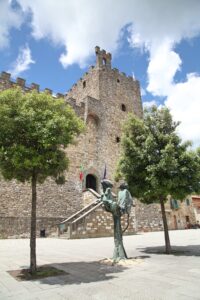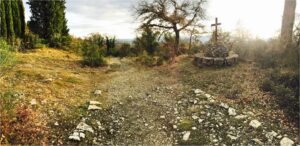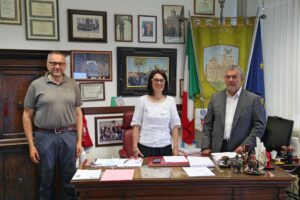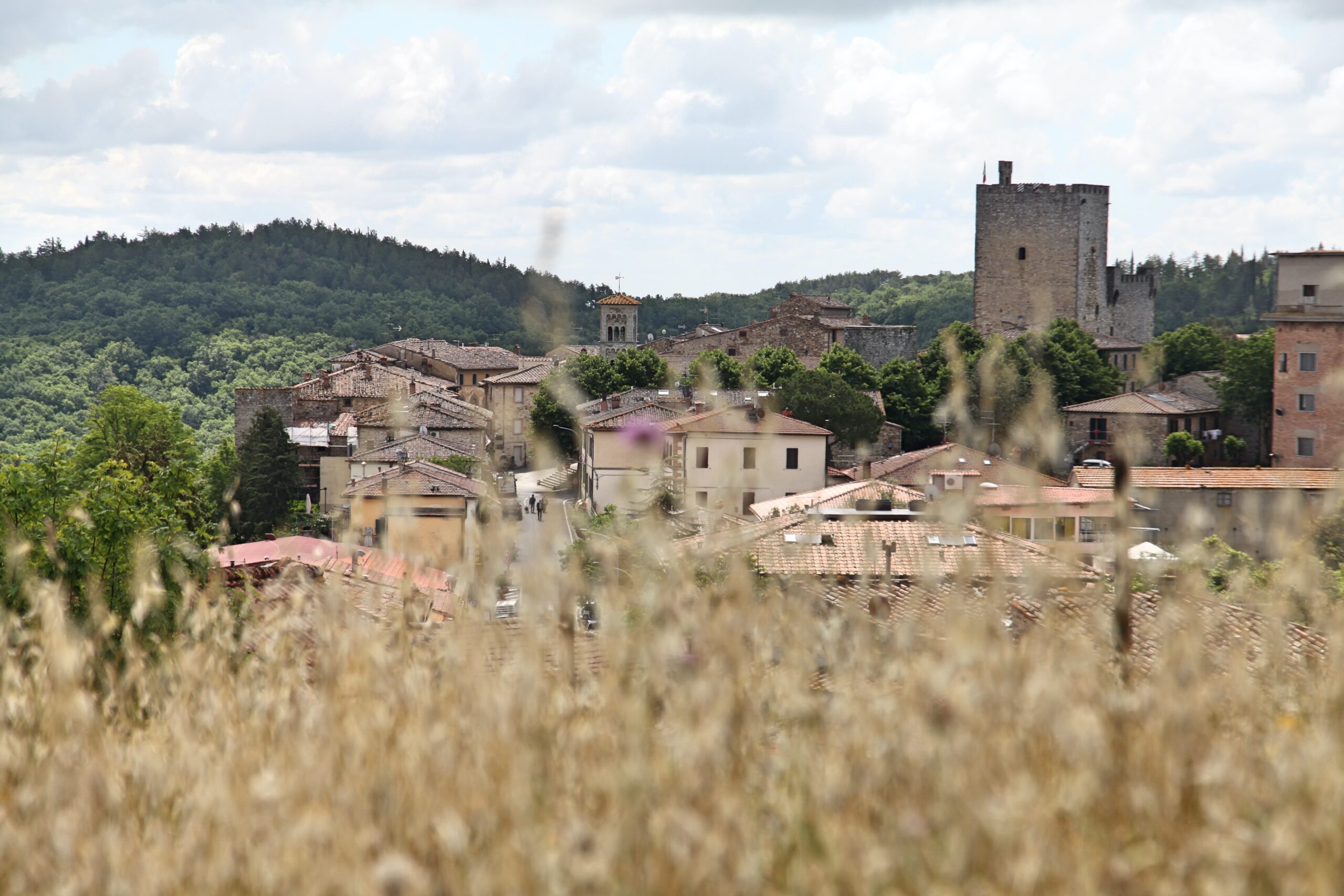At the premises of the Municipality of Castellina in Chianti we meet up with Giuseppe Stiaccini, the city councillor responsible for the Via Romea and area footpaths and with the Councilor for Culture Susanna Viviani to trace together the 78 kilometre route of unpaved tracks connecting Florence and Siena, which today we can finally traverse on foot, by bicycle or on horseback.
The interest around the Via Romea Sanese, the ancient route that connected Florence to Siena passing through Chianti along a ridge until it joins the Via Francigena started already in the 1980s thanks to the historiographic efforts of professors Moretti and Stopani around the discovery of an ancient road that connected the two major cities, both Roman colonies, mentioned in many sources including the Statuto del Capitano del Popolo di Firenze (1322-1325), in which the road is found along with other important Florentine roads and the Libro vecchio di Strade [Old Book of Roads] of 1461, where a section called “Strada Sanese from Sambuco to Castellina” is mentioned.
 This discovery was followed in 2005 by a project by the Cassa di Risparmio di Firenze Foundation, which Castellina in Chianti headed, for the recovery of the historical itinerary of the Via Romea Sanese, from the earliest evidence that certifies its use as a path.
This discovery was followed in 2005 by a project by the Cassa di Risparmio di Firenze Foundation, which Castellina in Chianti headed, for the recovery of the historical itinerary of the Via Romea Sanese, from the earliest evidence that certifies its use as a path.
The project came to an end this year with the presentation of the Via Romea Sanese amongst the pathways of Tuscany, as a historical and landscape route of regional interest, a privileged focal point for entering into the experiences that thousands of people of different origins and at different times have had on this high gravel road, encountering characters and stories of this ancient territory that is “the son of its pathways and borders”.
You can get onto the Via Romea directly at Castellina in Chianti where you can also take the opportunity to visit the Etruscan tombs, in the four sites named as the Poggino di Fonterutoli, Montecalvario, Salivolpi and Casa Rosa al Taglio and study the historical traces of these settlements at the Archaeological Museum located in the central square at the foot of the Tower.
You will be taking a nature path that is dotted with history and tales of this territory, following in the footsteps of the ancients, be they settled folk or in motion, merchants, soldiers, wayfarers or wealthy landowners.
The rewarding high up natural trail winds through a predominantly stony terrain, passing small cultivated areas dedicated to wine and oil but largely given over to woodland.
There are 25 kilometers of path between San Donato in Poggio and Castellina Quercegrossa, along which the wonderful countryside reveals itself in all its natural beauty, shaped by the presence of man since his first settlements.
 You can grasp the significance of the Via Romea by following the trail of Holy Roman Emperor Otto III who issued the edict of Fonterutoli in 998 in order to put an end to the territorial controversies between the dioceses of Volterra, Siena, Fiesole, Florence and Arezzo, all interested in this strip of land and which in fact represents the first subdivision of the borders between the different settlements.
You can grasp the significance of the Via Romea by following the trail of Holy Roman Emperor Otto III who issued the edict of Fonterutoli in 998 in order to put an end to the territorial controversies between the dioceses of Volterra, Siena, Fiesole, Florence and Arezzo, all interested in this strip of land and which in fact represents the first subdivision of the borders between the different settlements.
You can also retrace the steps of the troops of the Florentine Republic, following the path of the Romea mentioned in the Book of Montaperti, which documents the passage of the Florentine troops along the way, right between San Donato in Poggio and Fonterutoli, making a stop in Ricavo, before starting again towards Siena.
Here we can weave our way with the folk of former times in the thriving commerce that linked up with the Via Francigena, follow the way of transhumance [the annual transposition of herds and people to upland pastures], feel the echo of famous sieges and savour the sense of peace of ancient rich holdings like the San Silvestro farm which can be seen from the road and was entered as a dowry for Lisa del Giocondo in 1495 and which undoubtedly attests to the presence of Mona Lisa here at some time in her life.
These are stories of travels and happy stays, which have contributed to drawing the entire landscape, as evidenced by the ingenuity of Giuliano da Sangallo, a pioneer of Renaissance architecture and promoter of the castellinesi fortifications on behalf of the Florentine Republic who also certainly arrived in Castellina in Chianti following our Via Romea.
It is in fact a greenway between Florence and Siena on which one can fully enjoy the hospitality of the territory, losing oneself along the tracks of previous travellers and finding one’s way too in places that were the inspiration of Leonardo, whose drawing of the ruins at Montecalvario is kept in the Louvre in Paris.
 Whether you are a lover of history or passionate about paths and landscapes, we strongly advise you to travel at least a part of it, because it is an unmissable opportunity to get in touch with the history of Chianti and a great opportunity to understand the synergy of nature and the human presence in the creation of the extraordinary Chianti area.
Whether you are a lover of history or passionate about paths and landscapes, we strongly advise you to travel at least a part of it, because it is an unmissable opportunity to get in touch with the history of Chianti and a great opportunity to understand the synergy of nature and the human presence in the creation of the extraordinary Chianti area.
For the organization of your itinerary or for technical advice and service information, you can contact the Castellina in Chianti Tourist Office, located in Via Ferruccio, who will be able to show you all the options for the trail, providing you with a map, informing you on the availability of public transport along the way and updating you on the timetable of the Archaeological Museum to book a guided tour.
Info: Ufficio Turistico di Castellina in Chianti, Via Ferruccio 40/ tel. 0577 741392/ mob. 360 1094942/ ufficioturistico@comune.castellina.si.it
